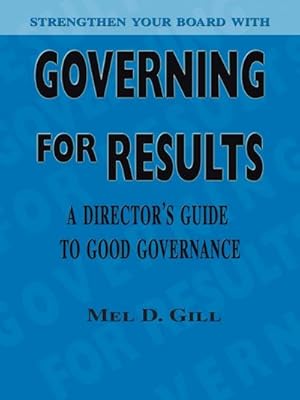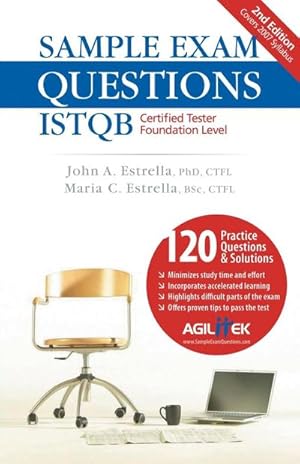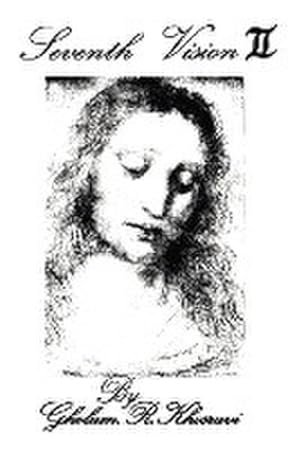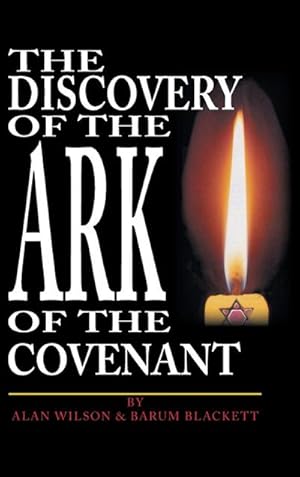trafford publishing aug 2007 (5 resultados)
Tipo de artículo
- Todo tipo de artículos
- Libros (5)
- Revistas y publicaciones
- Cómics
- Partituras
- Arte, grabados y pósters
- Fotografías
- Mapas
-
Manuscritos y
coleccionismo de papel
Condición
- Todo
- Nuevos
- Antiguos o usados
Encuadernación
Más atributos
- Primera edición
- Firmado
- Sobrecubierta
- Con imágenes del vendedor
- Sin impresión bajo demanda
Ubicación del vendedor
Valoración de los vendedores
-
Governing for Results
Publicado por Trafford Publishing Aug 2007, 2007
ISBN 10: 1412049385ISBN 13: 9781412049382
Librería: BuchWeltWeit Ludwig Meier e.K., Bergisch Gladbach, Alemania
Libro Impresión bajo demanda
Taschenbuch. Condición: Neu. This item is printed on demand - it takes 3-4 days longer - Neuware -BEST SELLER This BEST SELLIING book provides a comprehensive guide to effective governance for board members and their senior executives. The author offers a new framework for understanding boards and proposes practices that boards can use to fulfill their stewardship responsibilities, strengthen board performance and improve organizational effectiveness. The book discusses the basics of governance - what it is and why it matters; essential duties and liabilities of the board and its members; and the essentials of an effective board/management partnership. It provides detailed guidance on the seven primary areas of board responsibility: i) mission and planning; ii) financial stewardship; iii) human resources stewardship; iv) performance monitoring and accountability; v) community representation and advocacy; vi) risk management; and, vii) managing 'critical events' and 'transitional phases'. It discusses the legal structure of nonprofits, who owns them and how to organize for accountable governance. Governing for Results will assist boards in dealing with recurring issues around board and committee structures; their terms of reference and effective use; and job descriptions for key officers. The discussion of board development, board management, decision-making and organizational culture will prove invaluable in helping many boards deal with these complex issues. A discussion of the essential principles of governing for results includes a logical framework for planning and evaluation. The book provides tools that can help boards decide which governance practices will best fit their particular organization and strengthen their performance as a governing body. It outlines the factors that may interfere with a board's ability to adopt appropriate governance practices and presents twelve keys to successful governance that were identified through research. It offers a sample letter of agreement for new board members, and samples of an agenda for board meetings, an oath of confidentiality, a values statement, conflict of interest and donor confidentiality policies, a template for financial monitoring, self-assessment tools for the board and individual directors and a basic guide to 'Rules of Order' for conduct of meetings. It also provides outlines for comprehensive by laws and governance policies, and references to additional resources. Although this book is intended to fill a gap in the resources available to volunteer members of nonprofit boards of directors, much of its guidance will also be useful for directors of public and private sector corporations. The strong research base underpinning this work also makes it of interest to researchers, academics, and consultants. It adds perspective to the debate about governance models and offers guidance to board members with respect to board structure, responsiblities, governance practices, and problems that commonly afflict boards. It is designed as a user-friendly guide for busy directors and executives who want concise, compact and well-researched answers to perennially troubling questions about governance, the role of boards and their relationship to staff. 184 pp. Englisch.
-
Sample Exam Questions
Publicado por Trafford Publishing Aug 2007, 2007
ISBN 10: 1425131336ISBN 13: 9781425131333
Librería: BuchWeltWeit Ludwig Meier e.K., Bergisch Gladbach, Alemania
Libro Impresión bajo demanda
Taschenbuch. Condición: Neu. This item is printed on demand - it takes 3-4 days longer - Neuware -Amazingly concise, this book immediately presents three complete sets of tough sample exam questions. Practice questions help you determine your preparedness for the actual exam. By strictly and proportionally addressing all topics in the ISTQB Certified Tester Foundation Level Syllabus, this book highlights the most difficult questions including test conditions, test cases, equivalence partitioning, boundary value analysis, decision tables, state transition diagrams, statement testing, decision testing, incident management, and much more! Software testing certification candidates will find the discussions on how the exam questions were written extremely insightful. Packed with practical tips, the solution chapters provide detailed answers for each question. Simple tricks from this book can significantly increase your chances of correctly answering unfamiliar questions. The proven tips and tricks will definitely boost your confidence when you take the actual exam. 204 pp. Englisch.
-
Seventh Vision II
Publicado por Trafford Publishing Aug 2007, 2007
ISBN 10: 1425137865ISBN 13: 9781425137861
Librería: BuchWeltWeit Ludwig Meier e.K., Bergisch Gladbach, Alemania
Libro Impresión bajo demanda
Buch. Condición: Neu. This item is printed on demand - it takes 3-4 days longer - Neuware -After 22 years of dedicated work on his designs the author presents the first volume/second volume of his unique collection of artistically designed symbols for the 26 letters of our alphabet. 664 pp. Englisch.
-
Seventh Vision I
Publicado por Trafford Publishing Aug 2007, 2007
ISBN 10: 1425137873ISBN 13: 9781425137878
Librería: BuchWeltWeit Ludwig Meier e.K., Bergisch Gladbach, Alemania
Libro Impresión bajo demanda
Buch. Condición: Neu. This item is printed on demand - it takes 3-4 days longer - Neuware -After 22 years of dedicated work on his designs the author presents the first volume/second volume of his unique collection of artistically designed symbols for the 26 letters of our alphabet. 672 pp. Englisch.
-
The Discovery of the Ark of the Covenant
Publicado por Trafford Publishing Aug 2007, 2007
ISBN 10: 1425141900ISBN 13: 9781425141905
Librería: BuchWeltWeit Ludwig Meier e.K., Bergisch Gladbach, Alemania
Libro Impresión bajo demanda
Buch. Condición: Neu. This item is printed on demand - it takes 3-4 days longer - Neuware -British history records that there were tow major migrations form the near east into Britain in antiquity. One was the fleet migration form Syria led by Albyne around 1560 BC, and the other was the second fleet migration from the Trojan Dardanelles areas in Western Turkey led by Brutus around 504 BC. Ancient alphabet inscriptions and other tangible and written records show that the second migration was that of the Ten Tribes of Israel. The same ancient Alphabet is found all the way along the British migration routes form Palestine, to Assyria, through Asia Minor to the Aegean and to Etruscan Italy and Rhaetian Switzerland. In Britain the Ten Tribes were known as the Khumry. This research began in 1976 some 31 years ago and it has met with nothing but opposition and obstruction. Around 1360 BC Moses has the fabulous box called the Ark of the Covenant made. This holy box was the national talisman of the Hebrew nation. It was revered as the place of the presence of the god Yahweh and the most holy thing belonging to the Hebrew nation. Aeries of events that included the Ark being seen as an invincible means of military success and in one disaster being captured by the Philistines ended when King David placed the Ark in the care of the family of Obed Edom, and he took the Ark to Jerusalem around 975 BC along with the family of Obed Edom, The next King was Solomon and he built a celebrated temple in Jerusalem to house the Ark, where annually the high priest entered the holy of holies chamber to serve the divine box. Nothing much is said of the Ark until c.790 BC the Judean King Ahaziah attached the Israelite King Jehoash and was totally defeated. The victorious Jehoash then went to Jerusalem where he took everything from the palace and everything from the temple, and he also took away the family of Obed Edom who are the family mentioned several times in the Bible as guardians of the Ark guardians of the Ark. Therefore, Jehoash removed the Ark from Jerusalem and took it north to Samaria. Nothing is said in the Biblical record of the Ark being anywhere near Jerusalem after this event in circa 790 BC. In 740-736 BC the Judean King Ahaz paid a huge bribe to the Assyrian Emperor Tiglathpilesar III to attack King Pekah of Ten Tribe Israel, and as a result Israel was totally crushed by the Assyrian army. A large number of Israelite nobles and leaders were immediately deported north to areas around Harran from where the patriarch Abraham has begun his migrations. In successive campaigns by the Assyrian emperors Shalmaneser IV, Sargon II, and Sennacherib great numbers of the Israelite nation were deported north and up into the areas north of Harran. In 702 BC Sennacherib recorded how he deported 200, 120 people in one mass exodus. The Assyrian records unmistakably and persistently call the Ten Tribes as the Khumry, It is a virtual certainty that these deported Ten Tribes took the Ark with them from Israel. Sennacherib was murdered by two of his sons in c. 687 BC and civil war Convulsed the Assyrian Empire and as the heir Esarhaddon fought the murders the massed Ten Tribes took the opportunity to move westwards across both the upper branches of the 'Y' shaped Euphrates river as described in the Book of Esdras II. They moved slowly and unstoppably through Siasia Minor and the Greeks recorded their migration as that of the Kimmerio-Khumry. There is a record of the Khumry having the Ark with them on this journey from north of Assyria through Asia Minor and to the Dardanelles. Finally around 650 BC the nation split into tow and one half migrated to Italy whilst the other half remained in the areas around Byzantium until circa 504 BC when they gathered on the island of Lemnos before sailing to Britain in the fleets. An inscribed stone that was found on Lemnos in 1876 and now in the Athens museum that records this gathering and the intent to sail to Britain. Either the Ark was taken to Etrurian Italy in circa 650 474 pp. Englisch.






